Why should my school respond to the racial strife swirling in America? Given the division in our nation, do I really want to risk conflict and controversy in my school community by encouraging conversations on diversity, equity, and inclusion? For school leaders—especially those who lead largley homogenous schools—these questions are not uncommon, as are considering school parents and donors who may be averse to engaging in the current racial issues of our day.
As a matter of fact, when The Barna Group asked Christian parents enrolled in ACSI member schools, as well as prospective parents of those schools, to rate 23 characteristics of a school from “essential” to “nice to have” to “not necessary” in 2017, the two least important characteristics Christian parents sought were schools that are “economically diverse” and “ethnically diverse.” Along these lines, in 2019, The Barna Group found that only two in five white practicing Christians (38%) believe the U.S. has a race problem.
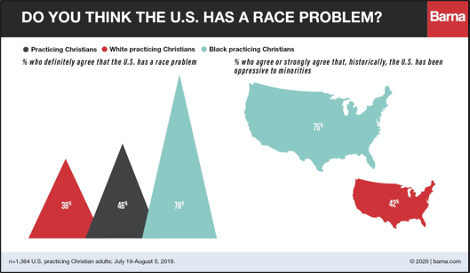
Recent events surrounding the murders of Ahmaud Arbery and George Floyd and the ensuing protests that have followed have further solidified the calls for justice in our nation and the importance of addressing issues of diversity, equity, and inclusion. But the question remains, do the majority of Christian parents now see the importance of diversity in Christian schools (whether socio-economic or ethnic) and training up their children to be the next generation of leaders to speak into these issues (or not) from a Gospel-centered worldview?
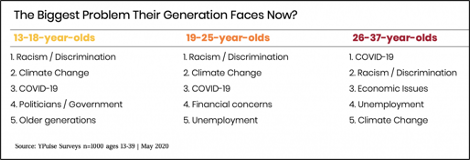
Furthermore, with many Christian schools experiencing a downturn in new admissions and inquiries, how are Christian leaders seeking to reach young, justice-minded millennials (ages 24 to 37 years old)—parents of the most racially and ethnically diverse generation in American history?
To better equip Gen Z students to engage their peers on challenging issues such as media discernment, faith, and race, the Imago Dei Leadership Forum commissioned The Barna Group to ask a series of questions to 979 diverse teens (ages 13-17) from around the country in November 2018 to write Parts 1-3 of the middle/upper school curriculum In Whose Image? These findings on Gen Z’s views of race and understanding of racial history—which will be featured in Part 3 of In Whose Image?—were both insightful and telling. When Gen Z teens were asked whether or not “there is a lot of anger and hostility between the different ethnic and racial groups in American today,” they overwhelmingly agreed—with African American students strongly agreeing by a 20-percentage point difference.
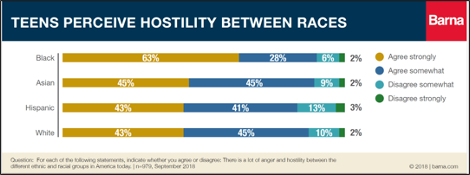
However, when asked whether or not they agreed or disagreed that “racism is mostly a problem of the past, not the present,” the disparities began to grow more—especially among black and white Gen Z teens.

The divide between black and white students became even more apparent among Gen Z teens when asked whether they agreed or disagreed with the statement, “People of color are often put at a social disadvantage because of their race.”
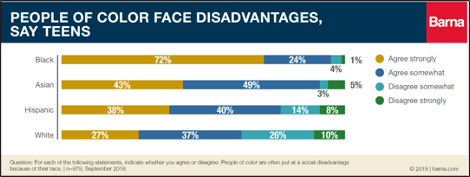
When it came to historical questions, the Barna polls were equally telling—especially the variance in Gen Z teens’ beliefs on the cause of slavery in America and whether or not statues of Confederate soldiers should remain in place.

The most disconcerting of all the polls, however, was how few Gen Z teens (particularly white students) could explain the hard lessons of U.S. history to someone not familiar with them—particularly the mistreatment of underrepresented groups in America, whether it be Asian Americans, Native Americans, African Americans, or women.
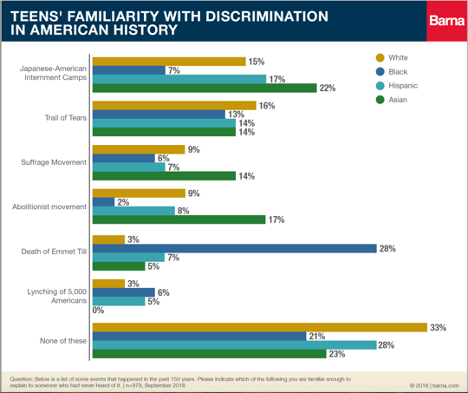
When I sat down to review the polling data, it confirmed what I had witnessed firsthand over the past six years teaching a racially diverse leadership group of Gen Z teens in St. Louis.
- First, Gen Z teens desperately need to understand their identity and faith in Jesus and how the Gospel calls them to view themselves and others as image-bearers of God.
- Second, Gen Z teens are clearly aware of the growing hostility in America. Therefore, they should be encouraged to be in community and conversation with peers of different races, so they can better understand how racism is still alive and well in America today and the ways people of color continue to face disadvantages. Students especially must be taught how to listen to one another—considering different views from their own and hearing the hearts and perspectives of others.
- Third, even if Gen Z teens are not in a diverse classroom setting, they need to understand why there are differing views on the cause of slavery in America and why statues of Confederate soldiers (particularly those erected during the Jim Crow era) are painful reminders of the evil institution of slavery and the discrimination and persecution African Americans faced for the next 100 years after the Civil War (leading up to the Civil Rights era). Even more importantly, teachers in non-diverse school settings must be equipped to show the differing worldviews to their students.
- Fourth, if Gen Z teens are not educated with a balanced view of history—showing both the successes and sins of our nation—they will not have the proper perspective and empathy necessary to treat all people as equals and speak into our past and present injustices.
Given the growing racial diversity in our nation, it is important that Christian schools prepare for and speak into issues of diversity, equity, and inclusion with the Gospel—especially as millennial parents seek diverse, culturally engaging, Gospel-centered environments for their children.
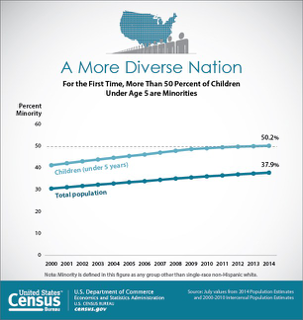
Furthermore, with the continued polarization and racial divide in America, coupled with the coming of the 2020 presidential election, Christian schools must ensure that the proper approach and training is in place for teachers to lead conversations on diversity, equity, and inclusion and what it means to bear the image of God—whether it be with diverse and/or homogeneous classrooms.
For when students understand what it means to bear God’s image, they are free to view themselves not as the world defines them but as God created them—pursuing their place and purpose in society, all the while growing and solidifying their faith in Jesus, applying the Gospel in loving ways, and treating others as equals.
Consider the words of Chaplain Barry Black at the 2017 National Prayer Breakfast:
“One day I memorized 1 Peter 1:18-19. I was only 10 years of age. It says, ‘We are redeemed not with corruptible things such as silver and gold but with the precious blood of Jesus Christ.’ Even at 10, I had sufficient analytical skills to know that the value of an object is based upon the price someone is willing to pay. And when it dawned on me, a little guy in the inner city, that God sent what John 3 calls in the Greek the ‘monogenes’—the only one of its kind—His only begotten Son to die for me, no one was ever able to make me feel inferior again.”
The power of the Gospel changed this 10-year-old boy from Baltimore—who would not only become an admiral in the Navy but would be elected to serve as chaplain of the U.S. Senate in 2003, the first African American chaplain since the Senate’s inception in 1789. And as our students embrace the Gospel—like a young Barry Black—I pray that our schools will prepare them to treat everyone as image-bearers of God, as we confront the virus of racism that continues to rear its ugly head in America.
“He has told you, O man, what is good; and what does the Lord require of you but to do justice, and to love kindness, and to walk humbly with your God?” —Micah 6:8
About the Author
 With 25 years in education—17 years as a head of school—Imago Dei Leadership Forum (IDLF) President John Murray is a thought leader in regard to equipping children and parents to impact modern culture for Jesus Christ. John has extensive experience in impacting the broader public through speaking, writing, and filmmaking. His award-winning articles addressing education, history, politics, media, and youth culture have appeared in numerous publications, including The Wall Street Journal, USA Today, The Barna Group, The Washington Examiner, The St. Louis Post-Dispatch, Des Moines Register, The Atlanta Constitution, Citizen Magazine, Movieguide, and Fox News.com to name a few. He has also appeared on several media outlets and podcasts including CNBC, MSNBC, USA Today, The Daily Signal, Breakpoint, World Magazine’s “The World and Everything in It,” and CNN Radio, and his award-winning documentary, Think About It: Understanding the Impact of TV-Movie Violence was nationally distributed by Active Parenting from 2000-2010. He is the author of In Whose Image? Image-bearers of God vs. The Image-makers of Our Time, and is the newly appointed head of school at Brookstone Schools, an urban K-8 school in Charlotte, NC. John can be reached via email at jmurray@idleadershipforum.org
With 25 years in education—17 years as a head of school—Imago Dei Leadership Forum (IDLF) President John Murray is a thought leader in regard to equipping children and parents to impact modern culture for Jesus Christ. John has extensive experience in impacting the broader public through speaking, writing, and filmmaking. His award-winning articles addressing education, history, politics, media, and youth culture have appeared in numerous publications, including The Wall Street Journal, USA Today, The Barna Group, The Washington Examiner, The St. Louis Post-Dispatch, Des Moines Register, The Atlanta Constitution, Citizen Magazine, Movieguide, and Fox News.com to name a few. He has also appeared on several media outlets and podcasts including CNBC, MSNBC, USA Today, The Daily Signal, Breakpoint, World Magazine’s “The World and Everything in It,” and CNN Radio, and his award-winning documentary, Think About It: Understanding the Impact of TV-Movie Violence was nationally distributed by Active Parenting from 2000-2010. He is the author of In Whose Image? Image-bearers of God vs. The Image-makers of Our Time, and is the newly appointed head of school at Brookstone Schools, an urban K-8 school in Charlotte, NC. John can be reached via email at jmurray@idleadershipforum.org

